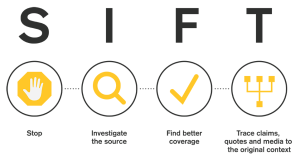

Propaganda: “the intentional manipulation of public opinion through lies, half-truths, & the selective re-telling of history.” (Oxford Reference)
Misinformation: “false, but not created or shared with the intention of causing harm.” (Cybersecurity & Infrastructure Security Agency)
Disinformation: “deliberately created to mislead, harm, or manipulate a person, social group, organization, or country.” (Cybersecurity & Infrastructure Security Agency)
Manipulated media: Photoshops, edited “cheapfakes” and some deepfakes.
Fabricated media: Generated media, like fake faces, and some deepfakes.
False context: When a photo, piece of video or even entire event is taken out of content and attached to a different narrative.
Imposter media: When someone pretends to be a reputable news source, or impersonates a news source.
Satire: Misinformation knowingly created for the purpose of entertainment or commentary.
Algorithm - “a step-by-step procedure for solving a problem or accomplishing some end.” (Merriam Webster)
Confirmation Bias: the tendency to seek out or interpret info that supports your beliefs or reject info that challenges your beliefs
Echo chamber: when your feed is only content you already agree with
Rabbit hole: website, platform, or profile designed to engage you so much that you stay there for a long period of time
Don't assume these sites are 100% accurate. Still use critical thinking to evaluate what you read
Ground News is an app and an extension that aggregates which outlets cover which news stories and where they lie politically regarding bias. The website has a lot of information, and the extension can also analyze every news story you open. They also have newsletters aimed at alerting you to your own bias when reading news to avoid confirmation bias and echo chambers.
I highly recommend subscribing to the Daily Gound! - Mrs. Myles
All Sides also focuses on media bias by analyzing news stories on their website.
Ad Fontes Media is an independent company that ranks news sources based on bias and analyzes their credibility. They continually fact-check news sources and evaluate them to create their chart. They are ranked by credibility from top to bottom, and from left to right, they show political bias.
Use the SIFT Method to check what you've read

*Created by Mike Caulfield
Look beyond the original post or article
Open a new tab to search the author, the organization, the website, etc.
Verify the info & understand the context in which it is presented
2017 MIT study: fake news spreads 10x faster than real or accurate news (science.org)
2018 PEW research study: 81% of YouTube users watched videos suggested by the algorithm. (pewresearch.org) YT CES Neal Mohal claimed 70% of the 1 billion hours of videos watched every day were recommended by their algo. The algo kept people watching 1 hour of video at a time.